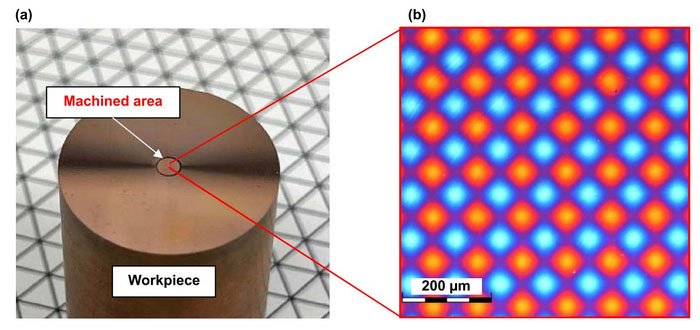| Oct 05, 2022 |
Tool path optimization made fast tool servo machining with nanometer precision possible
(Nanowerk News) Researchers at Keio University developed a novel tool path generation method for driving an independently controlled fast tool servo (FTS) for freeform surface machining. Without necessity of trial and error, the method enables rapid manufacturing of high-precision freeform optics (International Journal of Extreme Manufacturing, "Tool path generation and optimization for freeform surface diamond turning based on an independently controlled fast tool servo").
|
|
The tool path program was generated using the ring and mesh methods instead of the conventional spiral tool path. The tool path was optimized by analyzing the effect of interpolation error using form error prediction. The optimization of control points layout consists of two steps.
|
|
Initially, the number of control points is determined. Then, the optimal aspect ratio of the layout parameters is determined. Experimental validation by machining two-dimensional sinusoidal waves and micro-lens array demonstrated the effectiveness of the tool path optimization method proposed in this study. The proposed method reduced the shape error from submicron to 10 nm level for two-dimensional sinewave.
|
 |
| Spindle rotation/movement controlled by a machine controller is synchronized with tool oscillation motivated by an FTS controller. The exact synchronization depends on the tool path generation for the FTS. In this study, tool paths generated by the ring/mesh methods were optimized by predicting the machined surface profile through simulation and minimizing the deviation between the predicted and the designed surfaces. (Image: Yusuke Sato, Jiwang Yan)
|
|
Professor Jiwang Yan commented, “FTS-based diamond turning is an amazing method to fabricate freeform surfaces with high efficiency, but conventional FTS units driven by piezoelectric actuators have very small strokes in micrometer scale, limiting their applications. In recent years, long-stroke FTS units, equipped with voice coil driven air bearings, have been developed, which enable millimeter-level working strokes, and in turn, greatly expands the applications of FTS diamond turning. To improve the system compatibility and stability, those voice coil-based FTS units are independently driven by separate control systems. However, the tool path generation method for such FTS has not been established yet, which is regarded as a bottleneck”.
|
|
The researcher, Mr. Yusuke Sato said, “This study aims at proposing novel methods to generating and optimizing the tool path for the independent FTS control system to reduce form error of a machined surface caused by two-dimensional interpolation. Firstly, control point clouds are pre-generated in two different methods, namely, ring method and mesh method. Based on the distribution of the control points, the final machined surface profile is predicted and interpolated by simulation. Then, by comparing the simulated surface with the designed surface, the form error is obtained. By repetitively adjusting the parameters of the control points, the form error was minimized to the desired tolerance”.
|
|
This study establishes an important base for further developing ultraprecision machining technologies of freeform optics through diamond turning by using a FTS unit with a separate controller to achieve high accuracy without necessity of trial and error, which contribute to advanced manufacturing of high value-added products.
|
|
Professor Jiwang Yan said, "The developed tool path generation/optimization system makes the commercially available FTS units more precise and powerful. It is especially useful to improve the productivity of freeform optics which are widely employed in various products such as VR/AR systems, cameras, scanners, head-mounted displays, and components used in aerospace and biomedical engineering. Rapid manufacturing of such freeform surfaces may change the concepts of product design in the near future."
|

